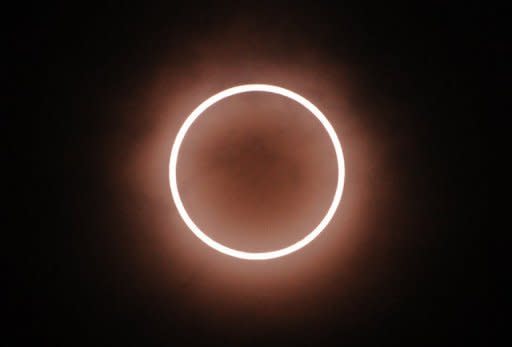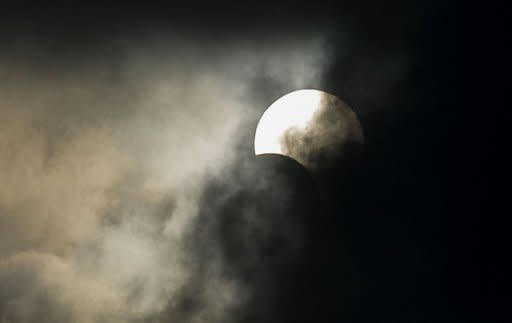Trans-Pacific 'ring of fire' eclipse wows sky-gazers
Millions of sky-gazers got the spectacle of a lifetime as a "ring of fire" solar eclipse crossed the Pacific from Asia to the United States, where it triggered whoops at festive viewing parties. The annular eclipse was visible in western US states from California to Texas late Sunday and in parts of China, Taiwan and Japan on Monday local time, making a 13,600-kilometre (8,500-mile) arc across the Pacific. "It was awesome," said schoolboy Marcos Doporto in Albuquerque, New Mexico, one of the biggest US cities on the exact path of the full "ring of fire" eclipse, visible for four minutes at its peak. "At first .. at the bottom it looked like someone ate it, but then after I waited a little while it started to get closer to looking kinda like (a) ring," he told KOB Eyewitness News 4 television. In Asia, clouds across much of southeastern China prevented a clear view, with some early risers in Hong Kong able to see only a small sliver of the "annular" eclipse and others coming away disappointed. An annular eclipse occurs when the moon passes in front of the sun, but is too far from the Earth to block it out completely, leaving the "ring of fire" visible. However, many in Tokyo got a spectacular sight as the sprawling Japanese capital of 30 million people received its first glimpse of the phenomenon in 173 years. Sadanobu Takahashi, 60, from Japan's northern Akita prefecture, said he and his wife joined a special two-day tour of Tokyo to watch the eclipse from the top of a 54-storey building in the Roppongi district. "Look! Now it's a perfect ring. How wonderful!" he cried out. Japan's major television stations cut live to the once-in-a-lifetime event, which has generated a mini-boom in spending on special tour packages and viewing glasses. Japan Airlines laid on a sold-out observation flight. Electronics giant Panasonic sent an expedition to the top of Mount Fuji, Japan's highest mountain at 3,776 metres (12,388 feet), to film the phenomenon using solar-powered equipment. One Japanese zoo reported that the eclipse sent a group of about 20 ring-tailed lemurs into a frenzy, as they were fooled into thinking it was nighttime. The lemurs at the Japan Monkey Centre in central Aichi prefecture jumped up and down wildly. "This is a behaviour that they usually take in the evening, so that they raise their body temperature," said zoo director Akira Kato. In Hong Kong, a few thousand optimistic early birds gathered on the Victoria Harbour waterfront hoping to catch a glimpse of the spectacle, but heavy cloud cover gave them only a brief window of less than a minute. "Who could not be disappointed?" said Thomas Goethals, a tourist from Belgium. Thousands in the western United States were banking on clearer skies as they ventured out at sunset on Sunday. One of the best spots in North America to see the full ring of fire effect was the tiny town of Kanarraville, Utah, where the local population of 350 was invaded by thousands of eclipse-watchers. T-shirts, flags and and bumper stickers touted the town as the eclipse "sweet spot," and there were also loud whoops when the full, annular eclipse was reached, some people watching through welders' masks. "I thought Utah was as good a gamble as any," David Lee, a member of the Royal Astronomical Society from Victoria, Canada, told the Salt Lake Tribune. Further west in Los Angeles, thousands were gathered for the viewing party at the hill-top Griffith Observatory, overlooking the city near the iconic Hollywood sign. In the cloudless skies over densely populated southern California, the eclipse peaked at 86 percent of the solar diameter, still blinding to the naked eye, but like a reverse crescent moon when viewed through a solar filter. The observatory ran out of $2.99 eclipse glasses two days before the event, and on Sunday was only selling larger "solarama" shields, limited to two per family to see the eclipse, the most spectacular in LA for 20 years. "It's amazing, it's phenomenal. It's unlike anything I ever expected, so I'm very excited to be here," said Dena Fargo, adding that it was the first eclipse she had ever seen "and I'm nearly 40, so it's about time".





